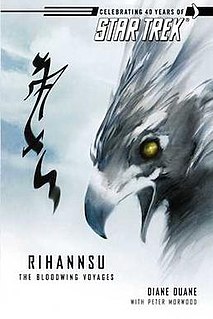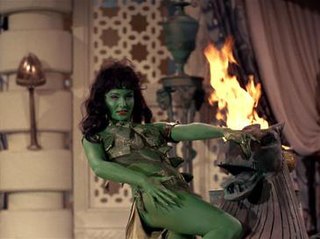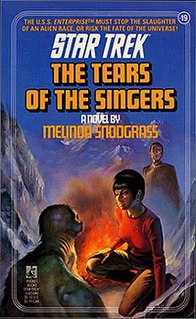
The Romulans are a fictional extraterrestrial race in the American science fiction franchise Star Trek. They first appeared in the series Star Trek (1966–1969). They have appeared in most subsequent Star Trek releases, including: The Animated Series, The Next Generation, Deep Space Nine, Voyager, Enterprise and Picard. They have also appeared in the Star Trek feature films Star Trek V: The Final Frontier (1989), Star Trek VI: The Undiscovered Country (1991), Star Trek: Nemesis (2002) and Star Trek (2009). They also appear in various other spin-off media, including books, comics, toys and games.

The Gorn are a fictional extraterrestrial humanoid reptilian species in the American science fiction franchise Star Trek. They first appeared in a 1967 episode of the original series, "Arena", in which Captain Kirk fights an unnamed Gorn on a rocky planet. The fight scene has become one of the best-remembered scenes of the original series, in part due to the slow and lumbering movement of the Gorn, which some viewers have considered unintentionally comical.

Saavik is a fictional character in the Star Trek universe. She first appeared in the film Star Trek II: The Wrath of Khan (1982) played by Kirstie Alley. Robin Curtis took over the role for Star Trek III: The Search for Spock (1984) and Star Trek IV: The Voyage Home (1986).

"Unification" is a two-part episode of the syndicated American science fiction television series Star Trek: The Next Generation, from the fifth season, which features Leonard Nimoy as Spock. It earned a 15.4 household Nielsen rating, drawing over 25 million viewers, making it one of the most watched episodes in all seven seasons of The Next Generation's run.
This article dicusses the fictional timeline of the Star Trek franchise. The franchise is primarily set in the future, ranging from the mid-22nd century to the late-24th century. However the franchise has also outlined a fictional future history of Earth prior to this, and, primarily through time travel plots, explored both past and further-future settings.
"The Magicks of Megas-tu" is the eighth episode of the first season of the American animated science fiction television series Star Trek: The Animated Series. It first aired on NBC on October 27, 1973, and was written by Larry Brody, who had originally pitched the idea for the third season of Star Trek: The Original Series. However, according to Brody the dialogue was mostly re-written by series creator Gene Roddenberry.

Star Trek: Rihannsu is a series of interlinked novels, written by Diane Duane and Peter Morwood, published by Pocket Books from 1984 to 2006. The series name was retroactively applied to the first novels with the release of new installments in 2000. A fifth novel was published in 2006.

The Orions are a fictional extraterrestrial humanoid species in the American science fiction franchise Star Trek, making their first appearance in the initial pilot for Star Trek: The Original Series, "The Cage". Susan Oliver portrayed the first Orion seen on screen, when her human character Vina was transformed into one, although it was Majel Barrett who underwent the original makeup test. The footage was subsequently used in the two-part episode "The Menagerie". Yvonne Craig, who was considered for the role of Vina, later played an Orion in "Whom Gods Destroy".
The Star Trek expanded universe is an unofficial, fan-created term to describe an extrapolation of events which occur in the Star Trek Universe outside the scope of the television series and feature films. Information from the Star Trek "Expanded Universe" typically fills "holes" in the Star Trek story and timeline, with explanations of events which have never been adequately explained through live action productions. The term was first used in 1966 by writer D.C. Fontana to describe information put forth in the backstory of Doctor Leonard McCoy.
"The Enterprise Incident" is the second episode of the third season of the American science fiction television series Star Trek. Written by D. C. Fontana and directed by John Meredyth Lucas, it was first broadcast September 27, 1968.
"The Survivor" is the sixth episode of the first season of the American animated science fiction television series Star Trek: The Animated Series. It first aired on NBC on October 13, 1973, and was written by James Schmerer and was directed by Hal Sutherland. Schmerer pitched an idea for an episode to producer D.C. Fontana called "The Chameleon", and together with the series creator Gene Roddenberry, it was developed into the final script.
"The Pirates of Orion" is the second season premiere episode of the American animated science fiction television series Star Trek: The Animated Series, the 17th episode overall. It first aired on NBC on September 7, 1974. It was directed by Bill Reed, and written by Howard Weinstein. The episode was Weinstein's first professional sale at the age of 19, making him, as of 2018, the youngest writer of any Star Trek TV episode.
"The Practical Joker" is the third episode of the second season of the American animated science fiction television series Star Trek, the 19th episode overall. It first aired in the NBC Saturday morning lineup on September 21, 1974, and was written by American television writers Chuck Menville and Len Janson who together also wrote the first season episode "Once Upon a Planet". The "Rec Room" in this episode is the forerunner of the Holodeck, which plays a significant part in numerous episodes of the subsequent spin-off Star Trek series.

The Ashes of Eden is a Star Trek novel co-written by William Shatner, Judith Reeves-Stevens, and Garfield Reeves-Stevens as part of the "Shatnerverse" series of novels. This is Shatner's first Trek collaboration.

Strike Zone is a Star Trek: The Next Generation novel by Peter David, published by Pocket Books in March 1989. It was the author's first novel set in the Star Trek universe, although he had previously written stories for the DC Comics line of comics. Strike Zone was originally intended to feature the Romulans but this was scrapped, with the new aliens called the Kreel replacing them. It was also meant to feature the crew of the Enterprise from Star Trek: The Original Series but the publishers asked David to use those from The Next Generation instead.

The Tears of the Singers is a Star Trek: The Original Series novel written by Melinda M. Snodgrass. It was her first and only Star Trek novel, which led to Snodgrass writing for Star Trek: The Next Generation. Writer Victor Milan was also involved in the initial discussion of the plot for the novel.

Killing Time is a Star Trek: The Original Series novel written by Della Van Hise and published by Pocket Books in 1985. The original manuscript had Kirk/Spock slash fiction elements, and these were requested to be removed by Paramount. However, they were not removed, and 250,000 copies were printed. These romantic undertones between Spock and James T. Kirk were brought to the attention of the office of the creator of Star Trek, Gene Roddenberry, who made Pocket Books recall the first edition. This edition subsequently became a collector's item, with more than fifty changes made to a revised version.

The Pandora Principle is a science fiction novel by American writer Carolyn Clowes, part of the Star Trek: The Original Series. It features the origin story of Saavik, and how she came to know Spock.

Star Trek: The God Thing is an unproduced film script written by Star Trek series creator Gene Roddenberry. Following the success of Star Trek in broadcast syndication during the early 1970s, Paramount Pictures sought to produce a feature film based on the property. The film's plot follows the Enterprise crew after the events of The Original Series: when an alien entity declares itself God and begins travel to Earth, Admiral James T. Kirk reunites the crew, who send it back to its own dimension. Roddenberry completed the story on June 30, 1976, but Paramount rejected the script for reasons Roddenberry attributed to the religious views of company executives. The story was rewritten as "In Thy Image" for the proposed television series Star Trek: Phase II and then as Star Trek: The Motion Picture.












